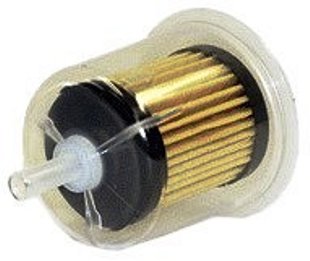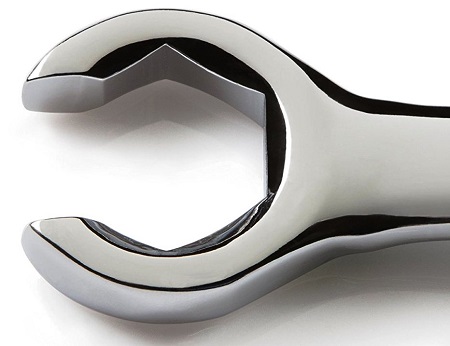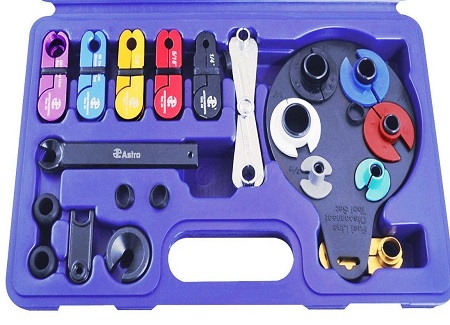Clogged Fuel Filter Symptoms
Here in this article we'll talk about what it feels like to drive a car with a clogged fuel filter. We'll also learn about the maintenance schedule for these important filters.
We'll also briefly mention a few car models that don't have serviceable fuel filters. Next we'll discuss some of the troubles you might run into when replacing a filter on an old car.
Finally, you'll see some of the special tools used to replace these maintenance items on old cars. We even included a tool used on older German cars from Mercedes-Benz and BMW.
Gasoline Fuel Filters: High Performance Fuel Filter, Premium Engine Protection, Compatible with popular models.
Before we get started let me tell you how to check for an original, never replaced, part and how to find the maintenance interval for this component.
How to Tell a Fuel Filter is Original
When the factory installs a fuel filter that is meant to be serviced at a certain mileage interval they usually mark the inlet with a permanent die.
On General Motors Corp. cars this is usually a small purple spot. On some Ford cars you'll find a green spot. Replacement parts are not marked this way.
This method lets dealership technicians know if owners are keeping up on required maintenance. If you see a fuel filter that has no markings, it has probably been replaced.
The question is when. This is why, whenever you purchase a used car ask for the maintenance records. Unfortunately, these important documents always seem to come up missing.
The next thing to find out is when it should be replaced. The expert on the maintenance interval of a fuel filter is the people that designed and built the car.
This is also where you find out if the part is even serviceable. On some cars, including Dodge, Nissan and the Infiniti Q50 they installed permanent filters inside the tank for a few years.
These do not require any scheduled service at all. Therefore, it is the owner's manual that has the most accurate information on when this item should be replaced.
Keep in mind these replacement guidelines are just a rule of thumb. If you live in a rural area that has a slow or inconsistent gas station in town you’re more likely to get debris in the tank that will clog a fuel filter. In these situations maintenance intervals should be increased.
Symptoms of a Clogged Fuel Cartridge
 Older Style Auto Fuel Filter
Older Style Auto Fuel FilterThe symptoms of a clogged gas filter are often similar to an automobile that's suffering with a defective fuel pump. In many cases these two components can fail together.
Without getting too deep into this type of scenario, the fuel pump can start to disintegrate and deposit the tiny ground up pieces directly into the filter element causing a clog.
Whether you just have a plugged filter or defective fuel pump the symptoms the car exhibits is related to a lack of gas pressure.
Lack of power is the main complaint in this situation. In fact the automobile might run perfectly at idle, but when the throttle is opened the car hesitates and might even stall.
It takes very little fuel to keep an engine running at idle speed without any load on it. A car will get it's maximum fuel economy when coasting with the throttle closed or your foot off the gas pedal.
When you apply a load by pushing down on the accelerator you need an ample amount of fuel to provide that power to get 3,000 lbs moving.
Therefore, stalling, hesitation and a severe lack of power are the main symptoms associated with a clogged fuel filter.
Mechanics diagnose this by taking a fuel pressure test. They can get a base line reading and then replace the filter.
Next they will run another pressure test and compare the numbers. There is no need to guess what’s wrong when testing can provide rock solid answers.
Replacing Fuel Filters on Old Cars
Replacing any parts on an old car can be problematic. This is especially true if it's been installed for a long period of time or original equipment.
I've come across 20-year-old cars with the original filter still installed. Replacing one this old is almost always difficult. To make matters worse, each brand automobile will have its own set of challenges to overcome.
On older General Motors Corp. cars the flare nut that attaches the fuel line to the filter is very soft. Using a standard open end wrench can easily damage the corners of the nut. When the corners are gone the job gets a lot harder.
 Flare Nut Wrench
Flare Nut WrenchThis is why they make flare nut wrenches. Sidebar: When I lived in New Jersey we called these line wrenches.
When I moved to Florida I discovered they use the term flare nut wrench. Nevertheless, these special tools have a small opening that fit over the line, yet applies more pressure on the stronger flat sides of a flair nut than the weaker corners.
These special automotive tools have more surface contact area than a standard open end wrench. You have to remember these specialized fuel system retainers are weaker than a standard solid bolt. It's always a good idea to apply penetrating oil to the threads and let it soak in before attempting removal.
Different Kinds of Gas Filters
After using these soft and troublesome flair nuts throughout the 80s and a good part of the 90s General Motors switched over to a quick to disconnect plastic retainer.
 Fuel Filter Special Tools Kit
Fuel Filter Special Tools KitYou have to push the line forward or toward the filter while at the same time releasing the lock tabs. This remains the secret trick that's required for uncoupling these old style fittings.
Eventually the nylon retainers would turn brittle with age and crumble when you pushed on them.
This required the entire fuel line to be replaced in some cases. General Motors then switched to an internal locking system that required a specialized fuel release tool. You can get one of these at any auto parts store.
With that said, it's similar to what Ford has used for many years. In the end a service manual for your exact year make and model automobile will not only tell you how to replace the fuel filter, but they will also inform you of what type of tool is needed to perform the operation.
Learn more about common tuneup and car maintenance problems. Visit the FixMyOldRide.com Homepage to see what else we cover on this website.
Author bio : Mark is a retired ASE certified master technician, Chevrolet Professional Service Council member and the founder of FixMyOldRide.com. Watch the video on the about Mark the mechanic page to see his credentials. Mark hand writes all of the articles on FixMyOldRide.com unless indicated otherwise.